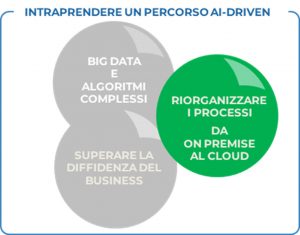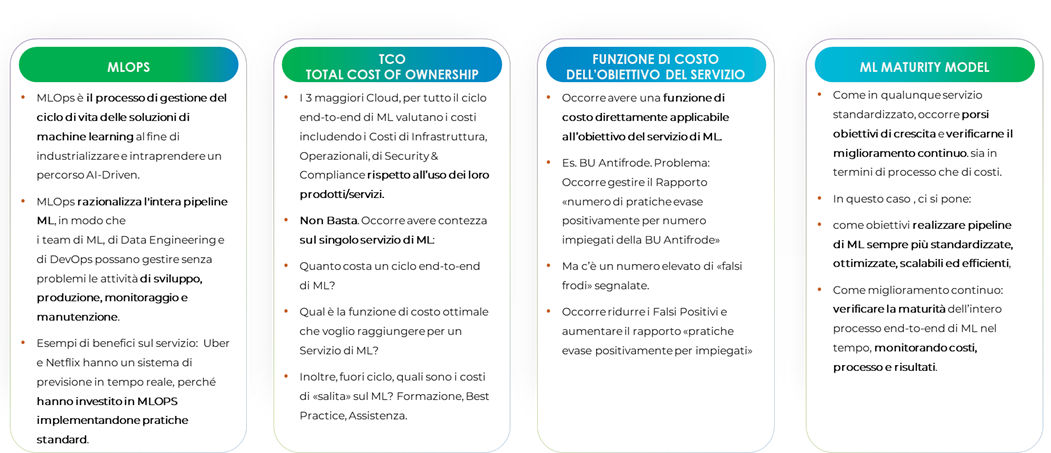In this article we want to explain in detail how companies can become AI-driven according to Humanativa Group.
There are 3 key problems to solve in order to embark on an AI-driven path:
-
- Big Data and Complex Algorithms
- Overcoming Business Distrust
- Reorganize Processes
Big Data and Complex Algorithms
For this first point, the Customer can often find himself in the situation in which:
- has large volumes of data that are certainly a good basis for any ML system for its initial learning
- but to solve his problem with ML, he must be able to use Complex ML Algorithms of the Last Generation
This is the typical situation for which ML Services in the Cloud are suggested.
Choosing the path of Cloud Services for ML means for the Customer:
- Equip yourself with the ability to reduce the complexity of Big Data processing with greater attention to techniques such as Distributed Computing that will define the right balance of a cost function.
Distributed Computing ensures the reduction of ML Model definition times both in the training phase and in the re-training phase (MLOps).
- Be aware of the Cost of Machine Learning in the Cloud
Highlights:
- Distributed Computing (reduces ML learning time).
Humanativa has expertise in distributed computing in the Cloud. Streamlining Distributed Computing Models (or with alternative solutions such as GPU training) is a determining factor in Big Data and IOT, especially for neural network models.
We are able both to integrate the services offered by the major Cloud providers, and to provide new ML components and readaptable or “native” algorithms for distributed computing.
- Cost of Cloud ML:
We have experience on the costs of the 3 clouds.
Humanativa is able to provide services for cost optimization. Humanativa is engineering a Predictive Cost Analysis system (studying prediction algorithms that will be transformed into prediction services for the Customer).
Overcoming Business Distrust
The second point, “Overcoming the Distrust of Business” is the heart of the path. The so-called Business is the business unit that has a need for its service and to which it is necessary to propose solutions with ML. In order to understand and use advanced analytics, the business needs:
- possibility to experiment without being ML experts
- Easy-to-use, business-oriented ML tools
Humanativa is able to bring Business closer to AI & ML through the following lines:
- Training to the Business Customer to make it autonomous.
- Consulting for the improvement of Business Processes.
- Best Practices to monitor in a regulated manner the entire end-to-end process of an ML service (MLOps).
- Innovation. AI & ML techniques that accelerate and simplify the use of ML.
The key to overcoming the Distrust of Business is to introduce the concept of Ease of Use of ML for Domain Experts.
Achieving ease of use means making both the process of creating a model (e.g. via AutoML) and the model delivery process (via MLOps) “operationally” easier. How so? These two themes are offered by Humanativa both as Operational Consulting and Process Governance. We are therefore able to offer:
- Operational Consulting:
- AutoML integration. govern and manage the AutoML features proposed by the major Cloud services both to produce and to experiment Models.
- Regulated and replicable MLOps Pipelines to automate the in-service delivery process of the Models.
- Process Governance Consultancy:
- Monitor results and manage re-training.
- Monitor ML costs both in the estimation phase and during production use.
More generally, following the orientation of Cloud Services, depending on the problem to be solved with ML, we can assume that in large customers it is possible the co-presence of multiple Cloud service providers (see Google GCP, Amazon AWS, Microsoft Azure) in a “MultiCloud” situation. In the case of Auto-ML, for example, we are able to give indications on which service (AWS, GCP or Azure) is best suited to solving an ML problem.

In conclusion, referring to our HN ML Method, simplifying the usability of ML means accompanying the Customer in all phases: from the use of the basic services offered by Cloud managers, to the design and implementation of ML Models, to the management of the Costs of the ML Service.
Reorganizing Processes
The third point is related to the reorganization of processes related to ML services and must be addressed from different managerial and operational perspectives.
The following figure shows us 4 themes ranging from process management to cost control, to the growth over time of progressively greater maturity levels of Machine Learning services.
In few words:
- MLOps. Today when we talk about ML we usually think of the Learning phase for the production of Models, we do not think of the whole End-to-End Cycle that must be governed and monitored both operationally and in costs.
- Awareness and Governance of ML Costs throughout the end-to-end ML process and Monitor Cloud Cost in an agile way.
- Cost functions focused on the objective of the ML service
- Set as a goal the “continuous improvement” following your own Machine Learning Maturity Model for example:
- introducing gradually greater automatisms both in the modeling phase
- introducing gradually greater automatisms in the delivery and re-training phase of ML models
- reducing the latency of Model updates
- introducing alerts in the monitoring of ML results in production in order to update the ML Models in consideration of both the cost function of the ML service and the exceeding of error level thresholds when incompatible with the cost function.
- Training new professional figures to be introduced in the company to transform especially if you face the solution towards the AI-Cloud.
- take advantage of non-IAAS but Serverless resources: you pay only when you perform an activity.
In conclusion, in all 3 key points, set out in this brief guide to the AI-driven company, the “common thread” is basically Governing Machine Learning Processes and Costs, giving “confidence” to an innovation path that leads to a renewal of the company from all managerial, operational, know-how, costs, and finally the value of the end customer.






